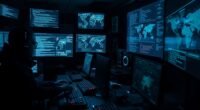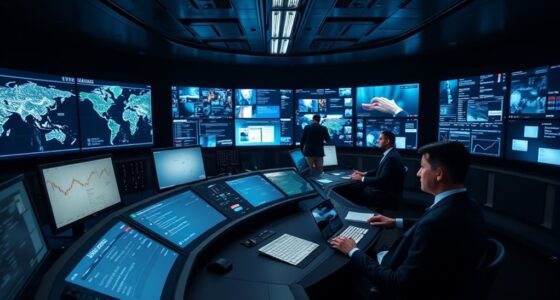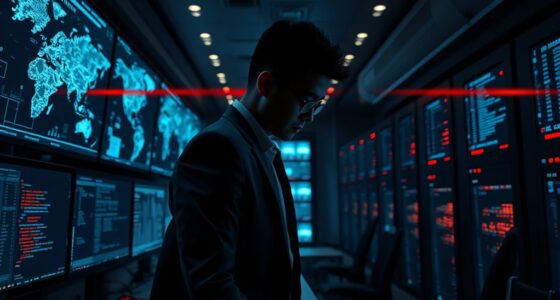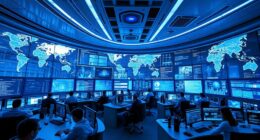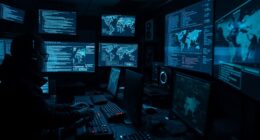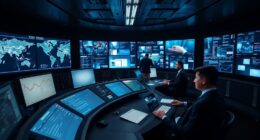Fusion centers are key hubs where local police, state agencies, and federal security teams come together to share essential intelligence. They connect your community with national security efforts by collecting, analyzing, and distributing data on potential threats. These centers help spot patterns, coordinate responses, and prevent crime or terrorism. While they enhance safety, they also raise concerns about privacy. Discover how these centers work and the balance they try to maintain as you explore further.
Key Takeaways
- Fusion centers serve as hubs where local, state, and federal agencies share critical security information.
- They facilitate real-time data analysis to identify and respond to threats proactively.
- Fusion centers improve coordination among law enforcement agencies and enhance national security efforts.
- They utilize advanced technology to track social media, financial, and travel data for threat detection.
- Oversight and privacy protections are essential to balance security needs with civil liberties.
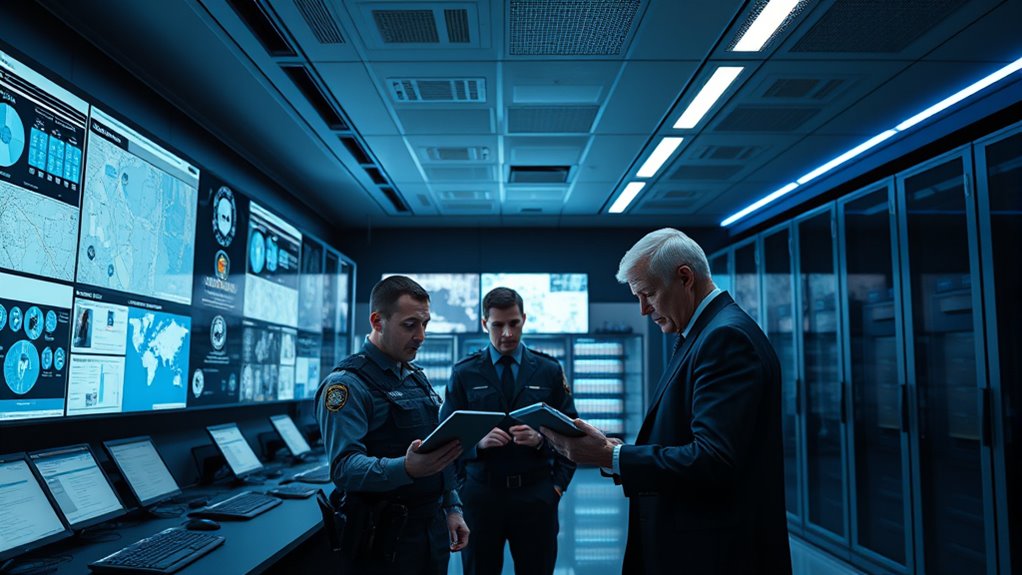
Have you ever wondered how law enforcement agencies connect the dots to prevent threats and solve crimes more effectively? That’s where fusion centers come into play. These hubs act as a bridge between local, state, and federal agencies, facilitating critical information sharing that enhances national security. When a suspicious activity is spotted in your community, fusion centers help gather and analyze data from various sources, creating an all-encompassing picture that wouldn’t be possible if agencies worked in isolation. By pooling intelligence, they enable law enforcement to identify patterns, detect emerging threats, and coordinate responses swiftly.
Fusion centers connect local, state, and federal agencies to share critical information and improve national security.
However, this system isn’t without its challenges. One of the primary concerns is privacy. As fusion centers collect and analyze vast amounts of data, including personal information, questions about individual privacy rights naturally arise. Critics worry that the broad scope of surveillance and information sharing could lead to unwarranted invasions of privacy or abuse of authority. For example, innocent citizens might be recorded or monitored without proper cause, raising fears about civil liberties. Agencies must strike a delicate balance: sharing enough intelligence to protect the public while respecting privacy boundaries. This often results in strict protocols and oversight to prevent misuse of sensitive information.
On the operational side, fusion centers employ advanced technology and data analytics to sift through massive data streams quickly. They can track social media activity, financial transactions, or even travel patterns to spot potential threats before they materialize. This proactive approach helps law enforcement stay ahead of criminals and terrorists, making communities safer. But it also heightens the importance of transparency and accountability, ensuring that the information sharing process doesn’t compromise individual rights or lead to discriminatory practices. Additionally, leveraging validated research enhances the effectiveness and reliability of their assessments.
In essence, fusion centers serve as a crucial link in the chain of national security, enabling different agencies to work together seamlessly. They foster collaboration that would be difficult to achieve otherwise, turning scattered data into actionable intelligence. Yet, this integration demands careful handling of privacy concerns, with clear policies and oversight to protect citizens’ rights. As technology advances and threats evolve, fusion centers will continue to adapt, balancing the need for information sharing with the imperative to uphold privacy and civil liberties. Ultimately, their success depends on maintaining that balance, ensuring they’re effective in safeguarding the public while respecting individual freedoms.
Frequently Asked Questions
How Do Fusion Centers Ensure Data Privacy and Civil Liberties?
You should know that fusion centers address privacy concerns and civil liberties by implementing strict data access controls and regular oversight. They guarantee sensitive information is protected through policies that restrict data sharing and enforce transparency. By conducting audits and training staff on privacy rights, fusion centers actively work to balance security needs with respecting individual civil liberties, helping to prevent abuses while maintaining effective intelligence sharing.
What Funding Sources Support Fusion Center Operations?
Imagine you’re in the 21st century, where fusion centers get funding from a mix of government grants, state budgets, and public-private partnerships. You’ll see interagency collaboration play a key role, with federal, state, and local agencies pooling resources. Sometimes, private sector contributions support technology and infrastructure. This diverse funding helps fusion centers operate effectively, ensuring they can share intelligence without skipping a beat, keeping your community safer.
How Are Fusion Center Personnel Trained in Intelligence Sharing?
You’re trained in intelligence sharing through specialized programs focused on data analysis and interagency coordination. These trainings help you understand how to gather, interpret, and share information efficiently across agencies. You participate in workshops, simulations, and joint exercises that enhance your skills in analyzing data and collaborating with other law enforcement entities. This thorough training guarantees you’re prepared to support national security efforts while working seamlessly with local and federal partners.
What Are the Legal Authorities Governing Fusion Center Activities?
You might think fusion centers operate in a legal vacuum, but they actually rely on strict legal frameworks and statutory authority. These laws define what activities are permissible, ensuring they don’t overstep boundaries. Federal laws like the USA PATRIOT Act and state statutes govern their operations, providing oversight and accountability. So, despite the secrecy, fusion centers are bound by legal authorities designed to balance security needs with civil liberties.
How Do Fusion Centers Measure Their Effectiveness?
You measure fusion center effectiveness through community engagement and technological integration. By tracking how well you share information with local communities and partner agencies, you see how effectively you build trust and collaboration. Additionally, you evaluate the success of your technological tools in identifying threats and supporting investigations. Regular assessments, feedback from stakeholders, and analyzing data flow help you determine if your fusion center is meeting its security and community goals.
Conclusion
Think of fusion centers as the lighthouse guiding ships safely through treacherous waters. They gather all the signals, shining a light on hidden dangers before they reach the shore. By working together, local cops and national security form a beacon of hope, illuminating the path toward safety. Just like a lighthouse protects sailors, fusion centers stand guard, ensuring our communities stay secure amid the storm of threats. Together, you’re part of that essential guiding light.

